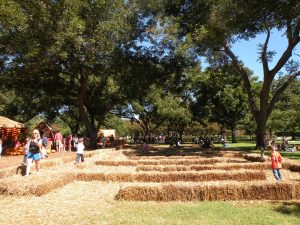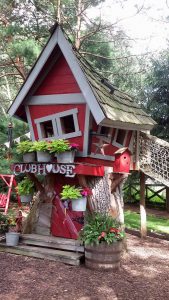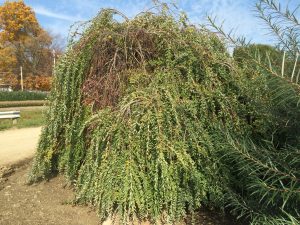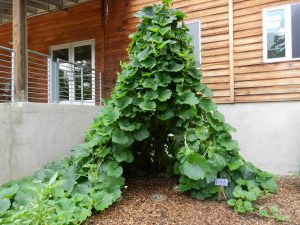Keeping to the theme of creating areas that are enjoyable for both kids and adults, I suggest one that is timely since Halloween will soon be upon us.

This hay bale maze is so short that even toddlers can enjoy it. If children are older, the height of the maze could be increased.
Amazing Options: By incorporating features that both children and adults enjoy, the garden can satisfy the needs of the entire family. Mazes are fun for visitors of all ages, and a wide variety of materials can be used to create them. If you are looking for a low, formal look, you might plant Teucrium (Germander); or, if a meadowy appearance is desired, try ornamental grasses such as Miscanthus (Maiden Grass) or Panicum virgatum (Switch Grass). Even simpler and less maintenance would be a maze of hay bales that could easily be dismantled.
The height of plant material used should depend on the ages and sizes of the children. Plants should be tall enough to impart a sense of adventure but not so tall that a child will become overwhelmed by fear. While kids will treat the maze as a quest, perhaps even purposely getting “lost”, adults often find it to be a meditative experience. If there is not enough space for a maze, turn a path into a tunnel with tall grasses or use a large Salix (Willow) on each side.

Raised bed sand pit that will later be converted to vegetables – Houzz
Sandboxes are the delight of children and the bane of parents. While children love to play with textures and move piles from one location to another, parents hate the dirt and grit and the necessity of a bath afterwards. An artist in Toronto constructed his child’s sandbox from concrete blocks, rimming it with brick and setting it into a patio and walkway. When the homeowners entertain, the sand is mounded into a conical sculpture. Should mess be a concern, it would be fairly easy to incorporate a child-sized shower nearby. If well-designed, the shower can become a sculptural element in the landscape as well.

This whimsical playhouse would have instant appeal to children.
Playing House: Playhouses appeal to many children because most are usually scaled to their physical dimensions. I have seen some that are absolutely charming but expensive, built to order and painted lovely colors; some even have a flower garden roof. However, many of the prefabricated structures disfigure the landscape and leave nothing to the imagination. In fact, I specifically screened out the neighbor’s playhouse – a plastic log cabin with a screaming yellow and green roof and door.

Think what fun it would be to hide out under the branches of this Weeping Pussy Willow..
Educators have long stressed that using imagination is crucial to developing a child’s thought process. Instead of giving kids a prebuilt playhouse, why not plant a weeping shrub or tree such Morus alba ‘Pendula’(Weeping Mulberry), Buddleia davidii (Butterfly Bush), or Salix caprea ‘Pendula’ (Weeping Pussy Willow) and place child-sized tables and chairs underneath? The area then becomes a playhouse, a private space and a tactile experience. Butterfly Bush is aptly named because it attracts a multitude of butterflies for all to enjoy; alternatively, Pussy Willow allows children to brush against the furry buds while adults can cut the stems for indoor arrangements.

Wouldn’t you like to spend a hot sunny day in a loofah tepee?
Another possibility is the creation of a tepee densely covered with vines. Loofah (Luffa aegyptiaca), a gourd-like vine, has large leaves and, of course, produces cucumber-like fruits that can be eaten or, if left on the plant to dry, can become sponges. However, I suggest Googling the steps necessary to effect this process.
I hope you will be able to incorporate some of these ideas for your children or grandchildren.


0 Comments